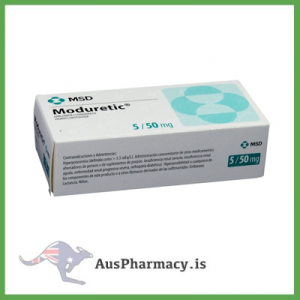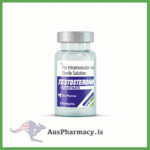Introduction
Moduretic 5/50 Tablets, combining Hydrochlorothiazide (50 mg) and Amiloride hydrochloride (5 mg), are widely referenced in pharmacology and renal physiology education.
The formulation represents a synergistic diuretic combination that demonstrates how two agents with opposing effects on potassium excretion can maintain electrolyte balance while promoting urinary output.
This article explores the mechanisms, pharmacodynamics, and educational significance of Moduretic 5/50 for students studying clinical pharmacology and pathophysiology.
1. Understanding Diuretics
Diuretics are drugs that increase urine output by influencing renal tubular function.
They are categorized by site and mechanism of action within the nephron:
-
Thiazide diuretics (e.g., Hydrochlorothiazide) — act on the distal convoluted tubule
-
Potassium-sparing diuretics (e.g., Amiloride) — act on the collecting duct
-
Loop diuretics — act on the ascending loop of Henle
Moduretic combines a thiazide and a potassium-sparing agent to illustrate how pharmacological synergy reduces the risk of hypokalemia while enhancing natriuresis.
2. Composition and Chemical Properties
| Component | Chemical Class | Formula | Primary Effect |
|---|---|---|---|
| Hydrochlorothiazide | Thiazide diuretic | C₇H₈ClN₃O₄S₂ | Promotes sodium and chloride excretion |
| Amiloride | Potassium-sparing diuretic | C₆H₈ClN₇O | Prevents potassium loss |
This dual composition is a classic example used in education to demonstrate how chemical diversity translates into pharmacological complementarity.
3. Mechanism of Action
Hydrochlorothiazide inhibits the Na⁺/Cl⁻ symporter in the distal convoluted tubule, reducing reabsorption of sodium and chloride. This increases urine volume and reduces plasma sodium.
Amiloride, on the other hand, blocks the epithelial sodium channels (ENaC) in the late distal tubule and collecting duct, preventing potassium secretion.
Educationally, Moduretic demonstrates how dual-site mechanistic action can balance therapeutic efficacy and safety.
4. Pharmacodynamics
-
Hydrochlorothiazide effects: Decreases blood volume, reduces sodium reabsorption, increases excretion of water, sodium, and chloride.
-
Amiloride effects: Decreases potassium and hydrogen ion loss, modulates sodium entry into cells, and counteracts thiazide-induced hypokalemia.
Together they achieve a balanced diuretic response, making Moduretic a valuable teaching model for combination drug therapy.
5. Pharmacokinetics
| Property | Hydrochlorothiazide | Amiloride |
|---|---|---|
| Absorption | 60–70% | 50% |
| Onset of action | 2 hours | 2 hours |
| Half-life | 6–15 hours | 6–9 hours |
| Excretion | Renal | Renal |
For students, these values illustrate how pharmacokinetic differences determine dosing intervals, onset times, and steady-state levels in combination therapy.
6. Physiological Basis of Action
In the nephron:
-
Thiazides act earlier (distal convoluted tubule) to reduce NaCl reabsorption.
-
Amiloride acts later (collecting duct) to limit potassium loss.
This two-step sequence exemplifies how combining agents can address different segments of the nephron to achieve a more complete diuretic effect.
7. Educational Applications
In academic programs, Moduretic is often referenced to:
-
Teach renal transport mechanisms and ion exchange
-
Demonstrate combination drug therapy design
-
Explain the importance of potassium homeostasis
-
Illustrate synergy in pharmacodynamics
Its mechanistic clarity makes it a model compound for problem-based learning modules in pharmacy and medical education.
8. Biochemical Mechanisms
Hydrochlorothiazide inhibits the Na⁺/Cl⁻ symporter, reducing intra-cellular sodium levels and altering cellular potential.
Amiloride blocks luminal ENaC channels, reducing sodium entry and minimizing potassium excretion.
Students can observe how this interaction modifies electrochemical gradients and transmembrane potentials in renal tubular cells.
9. Pharmacological Significance
The combination highlights:
-
Drug complementation: two agents working at distinct sites.
-
Safety optimization: amelioration of thiazide-induced hypokalemia.
-
Mechanistic synergy: enhanced natriuresis without excessive electrolyte loss.
It serves as a valuable educational example of how drug design addresses both efficacy and safety parameters.
10. Structure–Activity Relationship (SAR)
Hydrochlorothiazide’s benzothiadiazine core enables inhibition of Na⁺/Cl⁻ symporters, while Amiloride’s guanidinium group confers ENaC blockade.
Students learn how structural moieties determine target specificity and ion channel selectivity, essential concepts in medicinal chemistry.
11. Pharmacogenomics and Variability
Response to diuretics can vary with genetic differences in:
-
Sodium channel gene variants (ENaC mutations)
-
Renin–angiotensin–aldosterone system polymorphisms
In education, these examples highlight the relevance of pharmacogenomics in modern therapeutics and personalized medicine.
12. Safety and Handling in Academic Settings
For laboratory demonstrations, standard precautions are applied:
-
Use of gloves and protective eyewear
-
Proper labeling and storage of chemical samples
-
Safe disposal of residual materials
Educational institutions emphasize ethical handling of pharmaceutical substances used for demonstration or research.
13. Clinical and Educational Relevance
While clinical applications are beyond scope here, students study Moduretic to understand pathophysiological conditions where fluid and electrolyte management is crucial.
This includes lessons on homeostatic control, blood pressure regulation, and renal hemodynamics.
14. Current Research and Innovation
Recent academic research investigates:
-
Nanocarrier delivery systems for controlled diuretic release
-
Comparative efficacy of new thiazide-like agents
-
Computational models of ENaC channel inhibition
Moduretic serves as a reference point for evaluating novel approaches to diuretic design and renal therapeutics.
15. Ethical and Regulatory Perspective
Students studying pharmacy law and ethics can analyze how combination diuretics are regulated, highlighting:
-
Drug approval standards
-
Safety monitoring programs
-
Educational disclosure requirements for research use
Conclusion
Moduretic 5/50 (Hydrochlorothiazide and Amiloride) stands as a powerful educational model in the study of renal pharmacology, electrolyte homeostasis, and drug synergy.
By illustrating dual-mechanism diuretic activity, it bridges the gap between theoretical concepts and real-world applications in pharmacy and biomedical science.
For students, Moduretic represents an ideal reference compound for understanding how pharmacological principles are integrated into modern therapeutic strategies.





